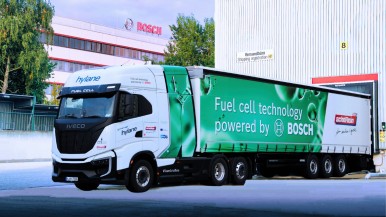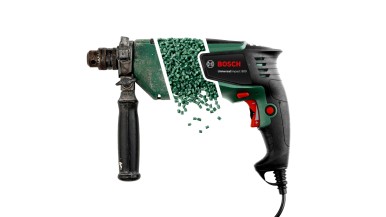Whether at work, in the car, or at home – robotics has the potential to improve people’s quality of life. In industry, robots will reduce the burdens placed on people by taking over hazardous and physically arduous activities. They can also support people in their private lives – but will not replace them.
In its research, Bosch focuses on the foundations and basic technologies for future generations of robots.
APAS
| APAS stands for automatic production assistant. It was developed to work safely with people. |
| The APAS systems (APAS assistant, APAS inspector) reduce the burdens placed on people by taking over hazardous, arduous, and monotonous activities. The robot is equipped with a sensor skin and stops if a person comes too close to it. |
| The APAS assistant can perform palletizing tasks, load heavy objects onto machines, or carry out packaging work. The APAS inspector can perform quality checks and has artificial intelligence. It can learn new tasks intuitively and rapidly. Both systems can be flexibly adapted to a wide variety of workspaces. |
| To further develop a robotics system that can flexibly, intelligently, and safely master the challenges of connected manufacturing (industry 4.0), such as situations where there are more variants in a smaller batch, all the way to one-off production. |
Dual-arm robot
| The dual-arm robot is made for industrial applications. Modeled on the human torso, it has two arms. |
| Thanks to its “physique,” the dual-arm robot has capabilities that are similar to those of a human. It can, for example, grasp objects with great precision. The dual-arm robot can be deployed in human workspaces without the need to make changes to these spaces. |
| Unlike APAS, this robot assumes tasks where putting its arms around an object or grasping objects with precision are required. This means it can hold an object with one arm, say, and work on it with the other. The two-armed robot is very light and can lift smaller loads. |
| Movement coordination will be further enhanced on the basis of the dual-arm robot. Furthermore, machine learning methods will be tested by having the robot learn new manufacturing tasks through simple imitation. |
ITA
| ITA is an intelligent transport assistant. |
| The robot adapts flexibly to changes in its environment. It can also immediately adapt to new tasks. If it encounters people as it moves around, ITA signals the direction it wants to take, warning people if they need to get out of the way. At a doorway, ITA decides whether to make way for people or go through itself first. |
| ITA is a robot that can be deployed in human environments such as office buildings or factory shop floors. Its purpose is to transport small objects, such as tools. |
| ITA prototypes are used to test and further enhance machine learning methods for a variety of robotics applications. |
Spencer
| Spencer stands for social situation-aware perception and action for cognitive robots. This means that Spencer has artificial intelligence and is able to learn from experience and develop social skills. |
| Spencer can find its way around in crowds of people. It knows its destination and how to get there. In doing so, it perceives people in its surroundings and takes social norms into consideration, such as keeping a minimum distance between itself and a person. At Schiphol Airport in Amsterdam, an experiment was carried out for two weeks in March 2016, in which Spencer took passengers for connecting flights to their gate. On its way, it updated them constantly regarding how far they were from the gate. It also provided this information to the airline. |
| Safely and quickly leading people from A to B. |
| Developing key technologies such as artificial intelligence, which allow robots to learn and to acquire social skills. This is important for all robots that are deployed in a human environment, whether in the workplace or the home. |
Kuri
| Kuri, the adorable home robot, was developed by the Bosch start-up Mayfield Robotics in the U.S. |
| Kuri is not a trendy tech gadget. Rather, it is able to learn to memorize certain faces and integrate with the people in its surroundings. Through head and eye movements, forward motion, and its light-up “heart,” it can communicate emotion. Kuri can capture film footage and take photographs, and has speech recognition technology (camera, loudspeaker, microphone, sensors). If it is alone in the house, it can alert the absent residents to a window left open by mistake, and in the evenings it can read a bedtime story to children. Kuri can be linked to a smartphone via an app. |
| Entertaining people, housekeeping, providing company, complementing the family (but it does not replace people). |
| Finding answers to the question of what robots need to have in order for people to accept them – and like them – in their most intimate personal spaces. |




